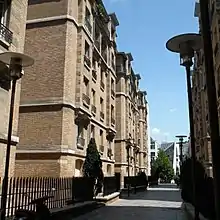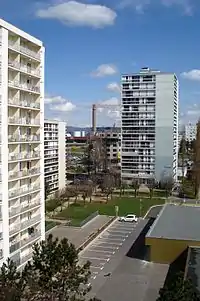HLM
An Habitation à Loyer Modéré (lit. 'housing at moderate rent'), generally called HLM (pronounced [aʃ ɛl ɛm]), is a form of low-income housing in France, Algeria, Senegal, and Quebec. It may be public or private, with rent subsidies.
%252C_barre_HLM_du_Jardin_Fr%C3%A9min.jpg.webp)
HLMs constitute 16% of all housing in France.[1] There are approximately four million such residences, housing an estimated 10 million people.[1] The standard of living in the HLM housing projects is often the lowest in the country.
72% of French HLMs built before 2001 (and 95% of those built between 2001 and 2011) are small buildings or individual houses. The average size of buildings is 20 apartments.[1] Construction of HLM is mainly financed by funds collected on Livret A, a type of savings account regulated by the Caisse des dépôts et consignations.[2] In 2011, the French people have placed 280 billion euros on this type of savings account.[3]
History

The HLM system was created in 1950 in response to France's postwar housing crisis. The low level of construction during and between the two world wars, the rural exodus that had started to take place in France (directed mainly at Île-de-France, the Paris region) and the baby boom, contributed to a deficit of an estimated four million residences. Eugène Claudius-Petit, the Minister for Reconstruction and Urbanisation, promoted a scheme of massive construction of socially subsidised residences to address this problem. The new system took its foundations from the HBM (habitation à bon marché – "inexpensive housing") system, which had been created in 1889 and financed mainly by charitable sources rather than the state.
The level of social construction did not significantly rise until minister Pierre Courant launched an ambitious plan in 1956, warranted by the increased rate of immigration from France's former colonies. Courant's plan had the goal of construction of at least 240,000 residences each year, and it was an unexpected success: from 1956 on, there were more than 300,000 new residences built annually, with a good number of them HLM. In 1964, there were 95,000 new HLM apartments. The residences were often constructed in large complexes, by le chemin de grue ("the way of the crane"). The new, large apartment buildings were perfectly rectangular, to allow a crane to roll along a track and place components on both sides of the building simultaneously, saving both time and effort.
The greatest increase in the number of HLMs came in the late 1960s and early 1970s, when many planned communities, or ZUP (zones à urbaniser en priorité: "priority urbanisation zones") were constructed. They were built mostly in the suburbs of Paris. A total of 195 ZUP were created, producing over two million new, mostly HLM, residences.
The emphasis shifted to improving the standard of living in the residences already in existence. In 1968, for example, only 41% of the HLM apartments had toilet and sanitary facilities. By the end of the 1970s, the figure had risen to about 80%. New HLM sites, with more rooms per residence, were built in smaller cities and towns, and numerous programmes were launched to combat poverty, unemployment and delinquency in ZUP communities. In 2001, each HLM residence had, on average, 2.4 persons living in it (compared to 3.2 in 1954), four rooms (three in 1954), and 96% of all HLM apartments had toilet and sanitary facilities, compared to only 10% in 1954.
References in popular culture
HLM high-rise estates, or cités HLM, are often referenced in French popular culture, as they are known for their enduringly high rates of poverty and unemployment as well as the concentration of first and second-generation immigrants in the communities. Many, if not most, well-known French hip hop artists come from the ZUP around Paris, including Sniper, 113, and Kery James. Rohff is known for his songs portraying life in the HLMs. The Tryo hit "L'hymne de nos campagnes" begins: Si tu es né dans une cité HLM..., "If you were born in a HLM..." (Mamagubida, 1998). British Sea Power also reference HLMs in their song "Living Is So Easy."
The popular singer Renaud wrote the song "Dans mon HLM" talking about life in HLMs and describing the typical neighbors you could find there back in the eighties.
In the postwar period, the HLM program was nearly synonymous with modernist high-rise apartment blocks.
See also
- Public housing
- Housing estate
- Affordable housing
- Subsidized housing
- Subsidized housing in the United States
- Section 8 (USA)
- Panelák and Sídlisko (Czech Republic and Slovakia)
- Khrushchyovka (Former Soviet Union)
- Plattenbau (Germany)
- Million Programme (Sweden)
- Panelház (Hungary)
- Council Housing (UK)
- Ville nouvelle ("new town")
- Banlieue
- Housing Development Board (Singapore)
References
- 10 idées reçues sur les HLM Archived 2013-11-26 at the Wayback Machine, Union sociale pour l'habitat, February 2012
- Mathias Thépot, Où va vraiment l'argent du Livret A ?, La Tribune, February 22, 2012
- Les Français confient 280 milliards d'euros au livret A et au LDD, La Tribune, 21 october 2011
External links
- Les organismes d'habitation à loyer modéré at Cour des Comptes (in French)
